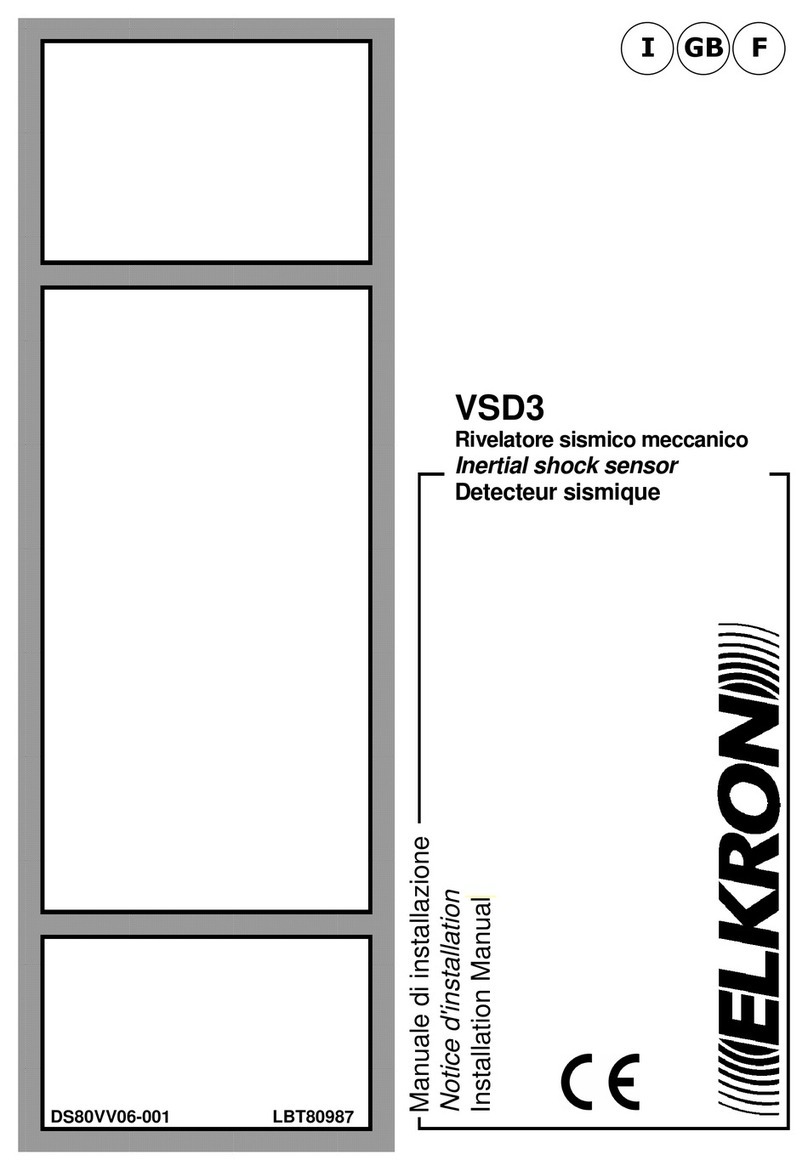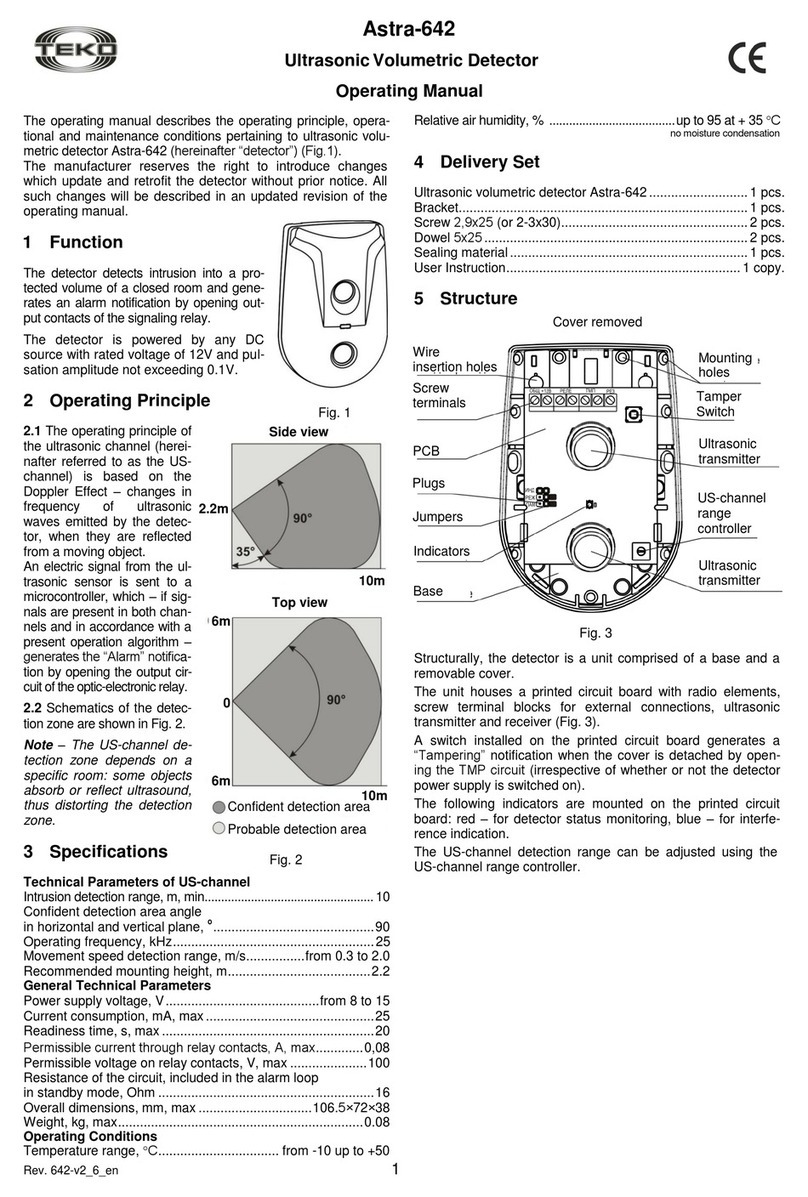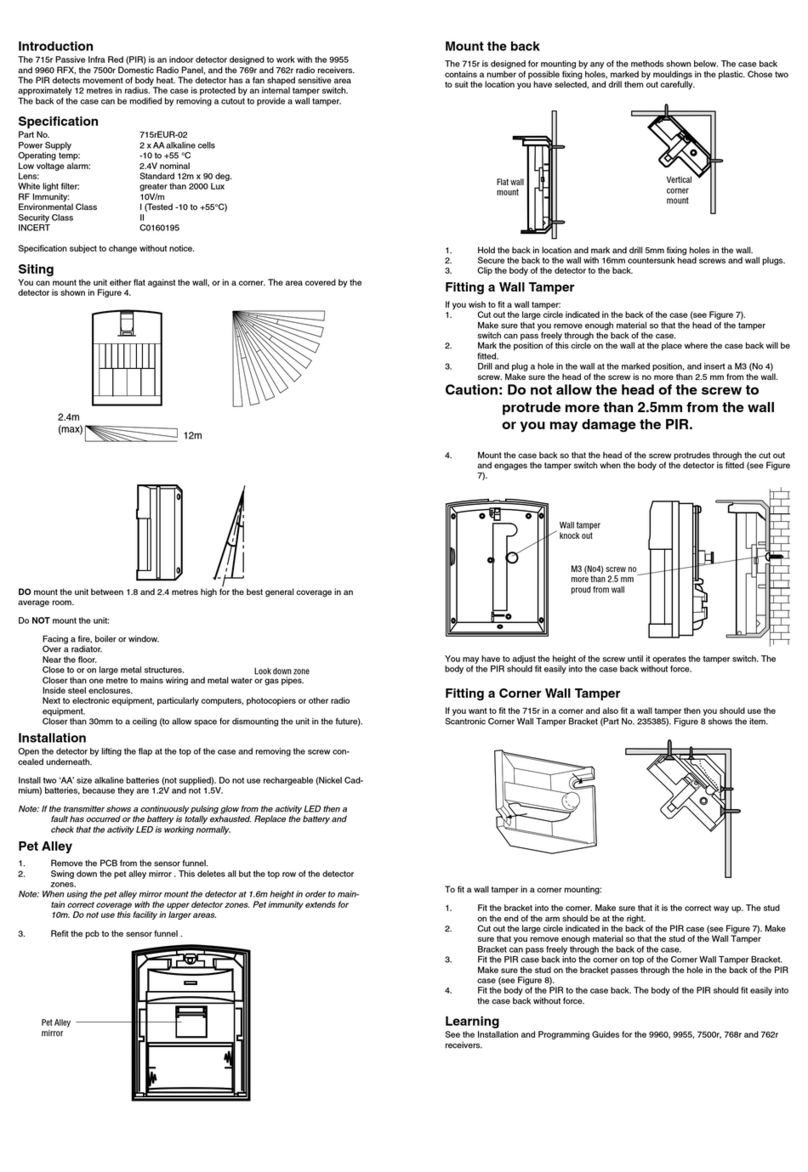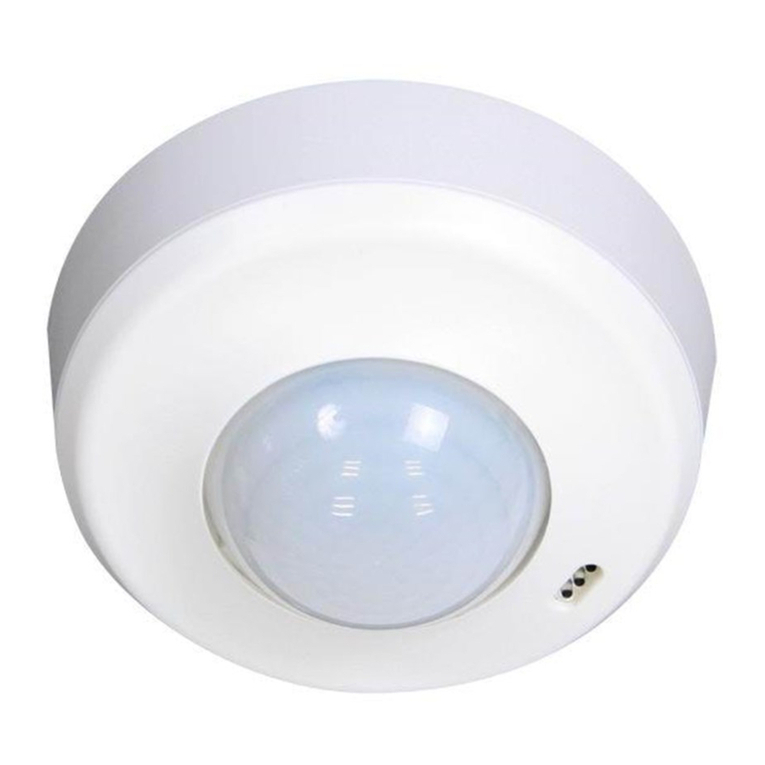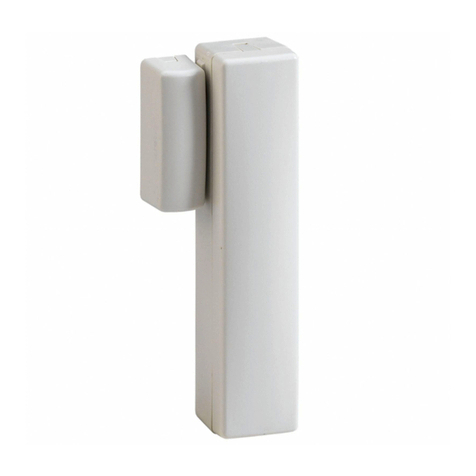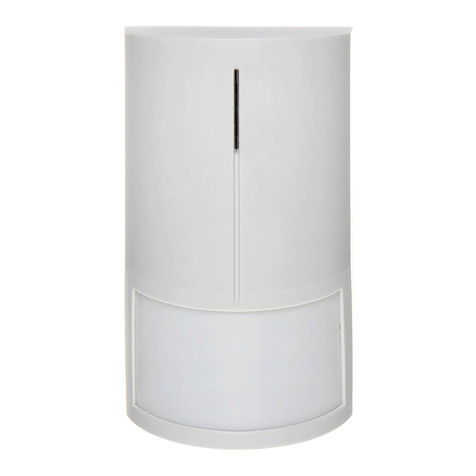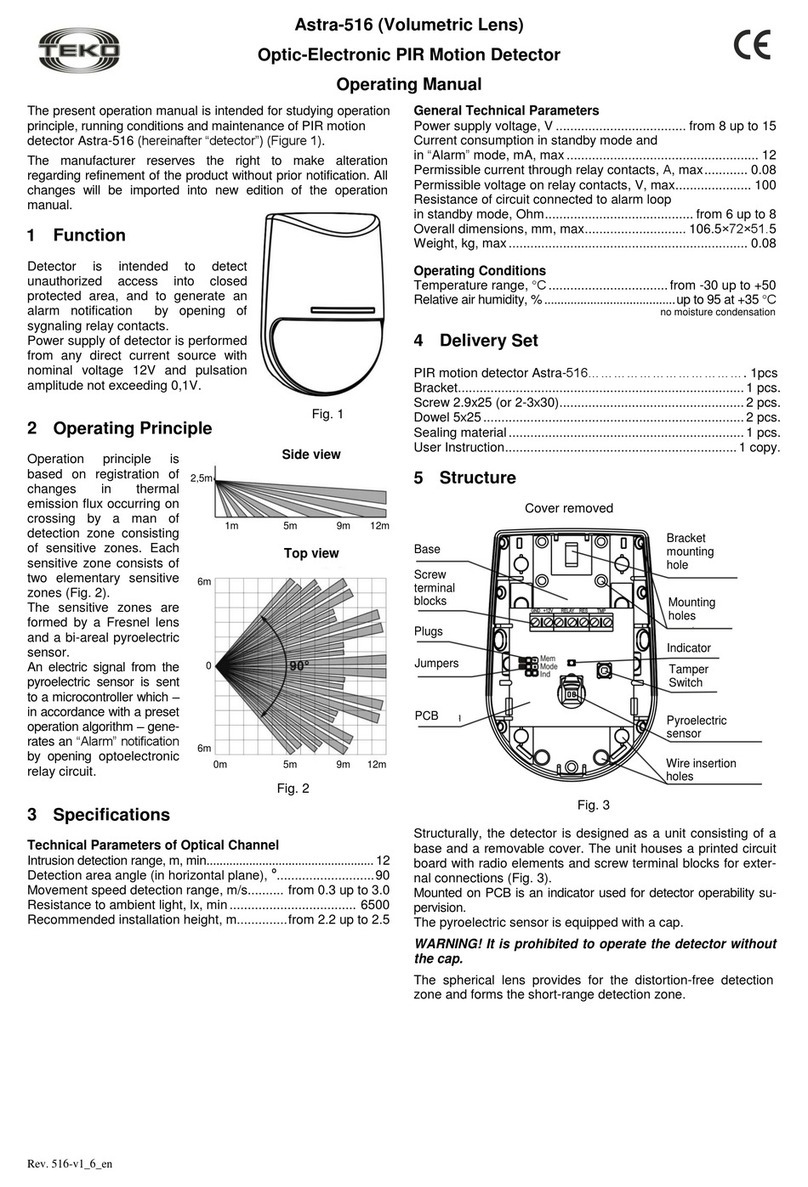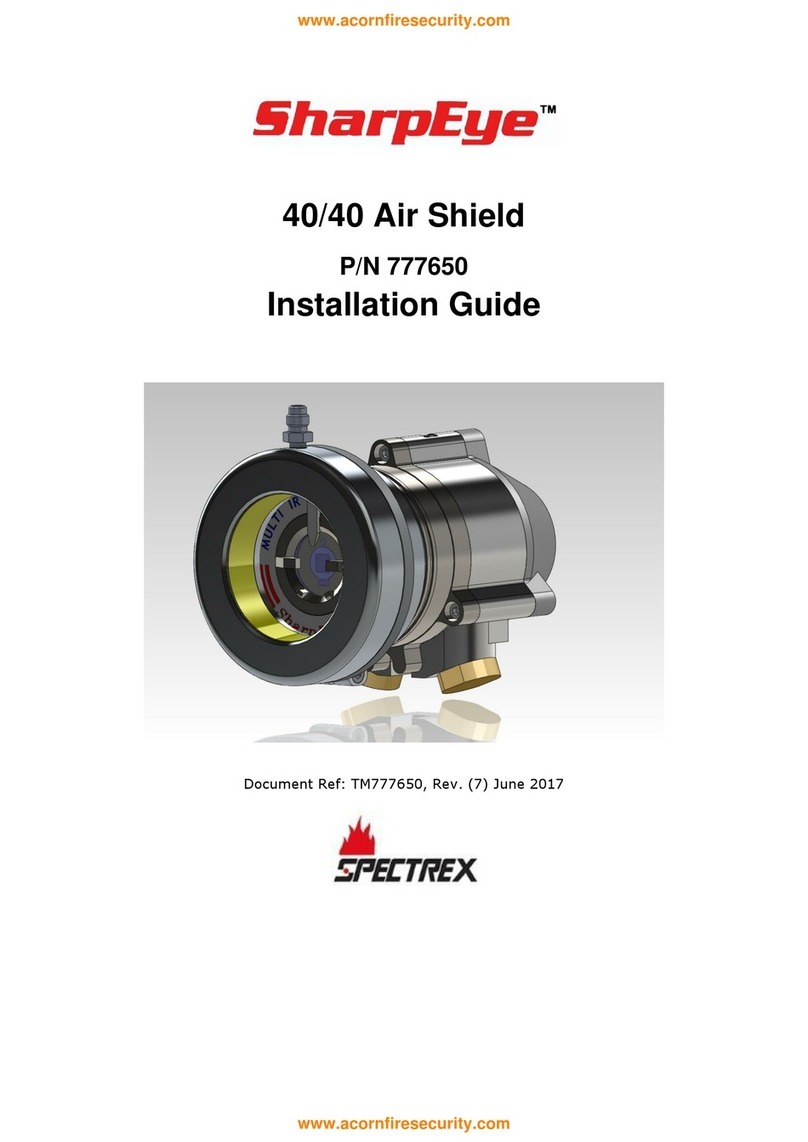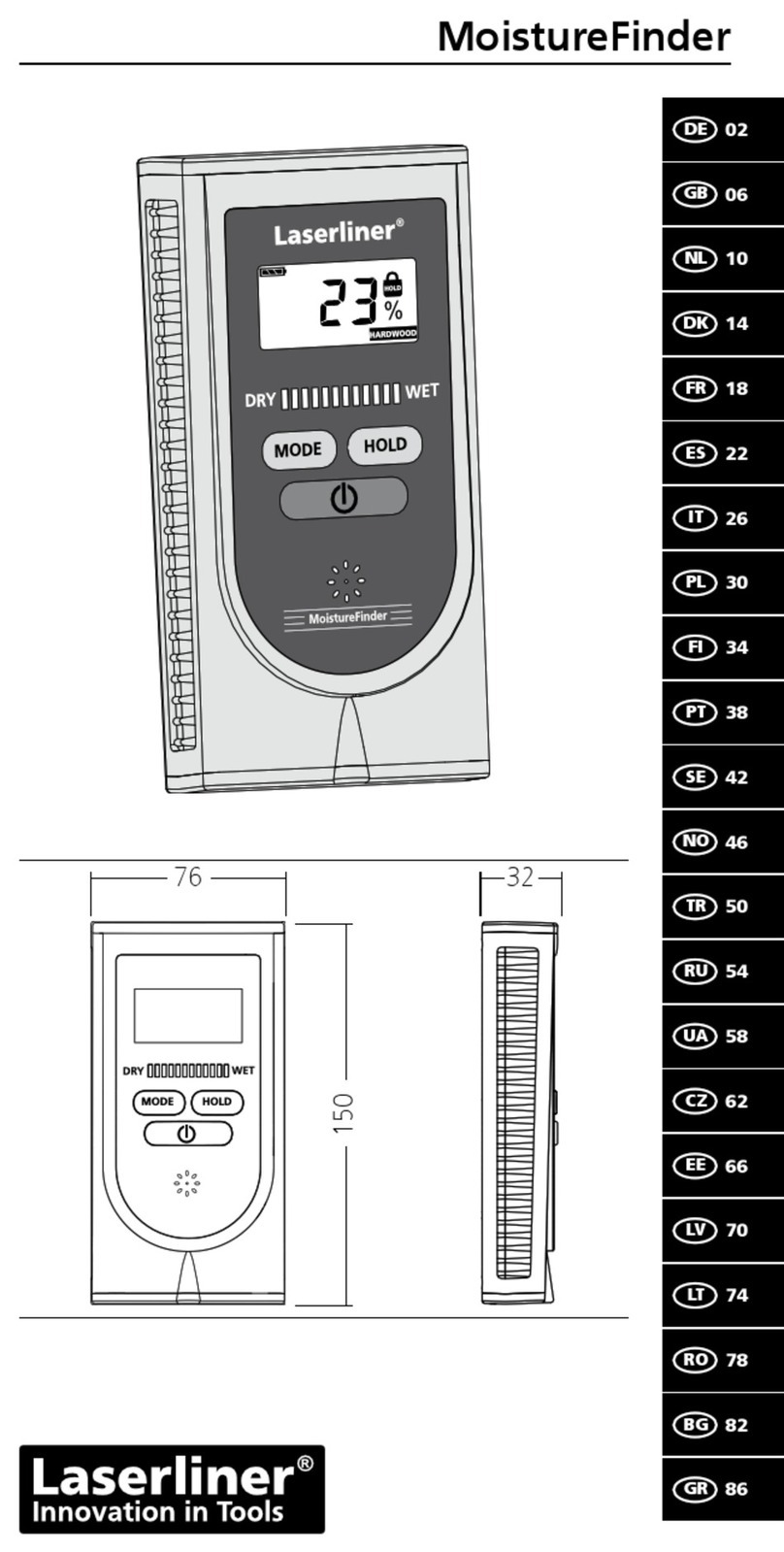BBC Bircher ProLoop2 User manual

LCD display
«Mode»-button
«Data»-button
Plug-in connection, 11-pin
Info LED
1
2Mechanical mounting in the switch cabinet
3Electrical connection
Safety instructions
1
These devices and their accessories may only be operated in compliance with the operating instructions (intended use)!
These devices and their accessories may only be commissioned by trained and qualified personnel.
These devices may only be operated with the intended supply voltage and parameters.
If malfunctions occur that cannot be rectified, shut down the device and send it in for repair.
These devices are only allowed to be repaired by the manufacturer. Tampering and alterations are not permitted. This will invalidate all guarantee and
warranty claims.
The 11-pin version of the ProLoop is mounted onto a mounting rail base (ES 12). This base is ordered and delivered separately as it is not included in the
scope of delivery.
The loop connection wiring to the loop detector must be twisted at least 20 times per meter.
Please wire the device in accordance with the terminal assignment. Make sure the terminals are assigned correctly.
General
Explanation of the LCD display Explanation of the LED
Standard display
1-loop device
Standard display
2-loop device Control button Control button
112
Mode
Sim1
Data
Sim2
12
Loop 2
Example:
Parameter
«h» set
Function
Example:
Time
function set
Loop 1
Info
Red & green: Start-up phase
Green: Operation
Red & green: Configuration
Flashing green: Loop activated
Flashing red: Error
Flashing
red + green: Simulation
The settings of the ProLoop devices in this chapter are shown and explained for the 1-loop device. The settings for loop 2 of a 2-loop device should be
made using the corresponding method.
4Value and parameter setting options
LCD display and controls
4.1
Check the electrical connection (base assignment) when exchanging a loop detector from another manufacturer.
A:
Supply
voltage
connection
B:
Loop connection
1-channel device
C1:
Loop connection
2-channel device
C21):
Loop connection
2-channel device
D:
Relay connection
output 1
E:
Relay connection
output 2
AC
AC
A1 (2)
11 (1)
(5) 22
(10) A2
(6) 21
no
nc
common
(3) 14
(11) 31
(4) 12
no
nc
common
32 (8)
24 (7)
34 (9)
1
32 (8)
24 (7)
34 (9)
1
2
Terminal connection diagram, ES 12 base assignment
24 (7)
32 (8)
34 (9)
1
2
1) Only applies to ProLoop2 with the designation «... .S.78. ... .»
ProLoop2 (11-pin)
Loop detector for industrial doors and gates, car parks and parking bollards
Translation of the original instructions
General
302111C
04/19
ENGLISH

Output 2 can also be set as an alarm output.
Output 2 8 (see Table 4.11b for settings)
4.8
Relay response to malfunctions (see chapter 6 Troubleshooting):
The relay picks up when the
loop is activated and drops
out when the loop is exited.
Loop
Relay
On delay:
The relay picks up after the
time t when the loop is acti-
vated and drops out when
the loop is exited.
Loop
Relay
t
Off delay:
The relay picks up when
the loop is activated and
drops out after the time t
when the loop is exited.
Loop
Relay
t
Activation pulse:
The relay picks up when the
loop is activated and drops
out again after the time t.
Loop
Relay
t
Impulse by leaving the loop:
By leaving the loop,
the relay picks up after
the time t, relay drops out.
Loop
Relay
t
1.Door/gate
systems
A malfunction causes
the output relay to be
released. The alarm
relay drops out.
2. Barrier
A malfunction causes
the output relay to pick
up. The alarm relay
drops out.
3. Quiescent
current
A malfunction causes
the output relay to be
released. The alarm
relay drops out.
4. Direction logic
(2-loop device
only)
A malfunction causes
the output relays to be
released.
Parameters
1: Door and gate The assigned output relay picks up when the loop is activated and drops out when the loop returns to a non-activated condition.
2: Barrier The assigned output relay picks up when the loop is activated and drops out when the loop returns to a non-activated condition.
3: Quiescent current The assigned output relay drops out when the loop is activated and picks up again when the loop returns to a non-activated condition.
4: Direction logic Output 1 switches if an object moves from loop 1 to 2. Output 2 switches if an object moves from loop 1 to 2. For a short time,
both loops must be activated. The output resets again when leaving the second loop. Both loops must have returned to a non-
activated condition for another direction detection.
0: Loop 2 Loop 2 can be deactivated in a 2-loop device.
The sensitivity 5 (= Sensitivity) of the loop detector can be adapted in 9 stages: 51 = Lowest sensitivity, 59 = Highest sensitivity,
56 = Factory setting. The sensitivity setting depends on the frequencies (see chapter 4.6 Frequency).
Four different frequencies F1, F2, F3, F4* can be set in order to avoid interference when using several loop detectors. These settings influence the
sensitivity (the sensitivity can be set in the range 1–7 for frequencies F1 to F3). F2 to F4 can be set for inductance < 150 µH and only F4 can be set for
inductance < 75 µH.
The direction logic function can only be used with a 2-loop device. Direction logic must have been set in the basic function (see chapter 4.2). Detection
can be performed from: ➝Loop 1 to loop 2 ➝From loop 2 to loop 1 ➝from both directions
ASB (= Automatic Sensitivity Boost). ASB is required in order to be able to recognise trailer drawbars after activation.
Basic functions 0 (see Table 4.11a for settings)
4.2
Time functions 1, time unit 2 and time factor 3 (see Table 4.11a for settings)
4.3
Sensitivity 4 (see Table 4.11a for settings)
4.4
Automatic Sensitivity Boost ASB 5 (see Table 4.11a for settings)
4.5
Frequency 6 (see Table 4.11a for settings)
4.6
Direction logic7 (see Table 4.11a for settings)
4.7
*factory settings
Note: The set parameter values are preserved in the case of a mains failure - regardless of the «Protection against supply voltage failure» function.
P 1 = Protection against supply voltage tailure activated: The sensitivity is restricted to 1–5.
Signal characteristics with protection against supply voltage failure active (Function 9 = 1)
4.9.1
For Activation (e.g. Barriers)
Basic function 0 = 2 Barrier systems
Without power Initialisation Free Occupied Free
For Safeguarding (e.g. Barriers, bollards)
Basic function 0 = 3 Quiescent current
Without power Initialisation Free Occupied Free
open (no)
closed (nc)
open (no)
closed (nc)
Output
Output
Protection against supply voltage failure 9 (see Table 4.11a for settings)
4.9
Display after start-up:
1
Touch the «Mode» button once
to change to configuration
mode
Mode
Sim1
1
Display after start-up:
12
Touch the «Mode» button once
to change to configuration
mode
Mode
Sim1
1
Mode
Sim1
2
Loop 2 is
selected
Loop 1 is
selected
1- loop device
2- loop device
Changeover from operation to configuration mode
4.10
Back to automatic mode: Press «Mode»-button >1 second)
2

3
Table 4.11b Addition to function 8 (configuration of output 2) and function 0
*factory settings
Loop 2 Output 2 Bemerkung
1-loop device, 2 relays –1/0/A* 1 = Output 2 active; 0 = Output 2 off; A = Output as alarm output
2-loop device, 2 relays active – Parameter 8 is not possible and is not displayed
deactivated 1/0*/A 1 = Output 2 active; 0 = Output 2 off; A = Output as alarm output
Function LCD
display
Button operation
functions
0 - Basic function
1
Mode
Sim1
1 - Time function
1
Mode
Sim1
2 - Time unit
1
Mode
Sim1
This display does
not appear with
time function th ()
3 - Time factor
1
Mode
Sim1
This display does
not appear wih time
function th ()
4 - Sensitivity
1
Mode
Sim1
5= Sensitivity
5 - Automatic
Sensitivity Boost
ASB
1
Mode
Sim1
ASB stands for
Automatic Sensiti-
vity Boost
6 - Frequency
1
Mode
Sim1
7 - Direction logic
1
2
Mode
Sim1
This display appears
only with a
2-loop device
8 - Output 2
configuration
1
Mode
Sim1
9 - Protection
against supply
voltage failure
Mode
Sim1
A - Operating mode
1
Data
Sim2
Data
Sim2
Data
Sim2
Data
Sim2
Data
Sim2
Data
Sim2
Notes
Door/gate
systems*
1
Barrier systems
1
Quiescent current
1
Direction logic
1
2
Only 2-loop device:
Loop 2
activated: «1»*
deactivated: «0»
2
With deactivation of Loop 2
the output 2 becomes
configurable g8
*
1
On delay
1
Off delay
1
Activation
pulse loop
1
Time funct. pulse
when loop is exited
1
Max. presence
1
0.1 second
1
1 second*
1
1 minute
1
1 hour
1
The time unit multiplied by
the time factor gives the
set time.
1*
1
Set value between 1
and 99 by touching or
holding the «Data»
button
4*
1
Set value betw. 1 (lowest)
and 9 (highest sensi.)
by touching or holding
the «Data» button
Setting restrictions:
rotection against supply
voltage failure (with P1):
Value 1-5
Switched off*
1
Switched on
1
Frequency F4*
1
Frequency F1
1
Frequency F2
1
Frequency F3
1
Both directi-
ons*
1
2
Loop 2 to
loop 1
1
2
Loop 1 to loop 2
1
2
The direction logic function
can only be implemented
with 2 loops and a 2-loop
device
Output 2 is
switched off
2
Output 2 is
connected as
an alarm output
2
Output 2 is bound
to loop 1
2
Loop 2 has to be
deactivated «0»
gBasic function
Supply voltage
failure:
Switched off*
Switched on If parameter 9= P 1
parameter 5 must be set to off
(5= A0 ).
Operating
mode
1
Error memory
slot 1 Error memory slot 2 Error memory
slot 3
Error memory
slot 3
Error memory
slot 5
Possible displays in case of
error: see chapter 6 of these
operating instructions
Button operation
parameter
4.11 Configuration mode
Table 4.1a Settings
Note on 2-loop device: After loop 1 has been set, the parameters for loop 2 are set (make the settings using the same procedure) and the settings are not shown in the table with the exception of the direction logic
Loop
Relay
t
Loop
Relay
Loop
Relay
t
Loop
Relay
t
Loop
Relay
t
Loop
Relay
t

ProLoop2 11-pin
Supply voltage /
Current consumption /
Power consumption
• 24ACDC: 24 VAC –20 % to +10 %, 84 mA, max. 1.8 VA
24 VDC –10 % to +20 %, 84 mA, 1.3 W
• 230 AC: 230 VAC –15 % to +10 %, 16 mA, max. 3.7 VA
Loop inductance max. 20 to 1000 µH,
ideally 80 to 300 µH
Loop connection wiring
At 20-40 µH: max. 100 m at 1.5 mm2
At >40 µH: max. 200 m with 1.5 mm2
min. twisted 20x/m
Loop resistance < 8 Ohm with connection wire
Output relay (loop) AC-1: max. 240 VAC; 2 A / DC-1: max. 30 VDC; 1 A
Dimensions 36 x 74 x 88 mm (W x H x D)
Housing mounting Mounting rail installation via 11-pin base ES 12
Connection type Screw terminals base ES 12
Protection class IP 20
Operating temperature –20°C to +60°C
Storage temperature –40°C to +70°C
Air humidity <95% non-condensing
Changeover to simulations mode Press «Sim1»
button
Press «Sim2»
button
Press «Sim2»
button
Press «Sim2»
button Anmerkungen
Changeover to simulation mode:
Press the Sim1 + Sim2 buttons
simultaneously for 2 seconds.
Mode
Sim1
2 seconds
+
Data
Sim2
2 seconds
1
Simulation mode:
Activation of the loop
1
Data
Sim2
1
Mode
Sim1
2
Data
Sim2
2
L0 -No loop activation (time functions are active)
L1 -Loop activation (time functions are active)
- Loop 1 - Loop 2
Activation of the output relay
Mode
Sim1
1
Data
Sim2
1
Mode
Sim1
2
Data
Sim2
2
00 - Activation of output
01 - Activation of output
- Loop 1 - Loop 2
Alarm output activation
Mode
Sim1
Data
Sim2
A0 -Switch off alarm relay
A1 -Switch on alarm relay
Inductance of loop 1
Mode
Sim1
1
Measurement of the inductance, value in µH
Inductance of loop 2
Mode
Sim1
2
Measurement of the inductance, value in µH
Exiting simulation mode
Mode
Sim1
2 seconds
12
Return to function mode
5Simulation mode
If an error occurs, operating mode «A» and error display «E» light up alternately and an error code such as E 012 is displayed. The LED changes to
flashing red, the 4 most recent errors are stored and can be interrogated.
Display E001 E002 E011 E012 E101 E102 E201/E202 E301 E302 E311 E312
Error Interruption
Loop 1
Interruption
Loop 2
Short circuit
Loop 1
Short circuit
Loop 2
Under-
voltage
Over-
voltage
Saving
error
Loop 1
too large
Loop 2
too large
Loop 1
too small
Loop 2
too small
Briefly pressing the «Data» button shows the last of 4 errors on the display. Another short press switches to the error before that, and so on. When
the button is pressed for the 5th time, the device switches back to automatic mode. If you press the «Data» button for 4 seconds during the query,
all error messages are deleted. The figure shows memory slot 1 in which error 001, Interruption loop 1, has been stored (example).
6Troubleshooting
7Reset
Mode
Sim1
2 Sekunden
Reset 1 (recalibration)
The loop(s) is/are recalibrated.
Mode
Sim1
8 Sekunden
Data
Sim2
Reset 2 (factory setting)
All values (except the error memory) are reset to the factory
settings (see Table 4.11a). The loop(s) is/are recalibrated.
8Most important technical data
EU Declaration of Conformity
9
WEEE
10
Devices with this symbol must be treated separately during disposal. This must be done in accordance with the laws of the respective countries
for environmentally sound disposal, processing and recycling of electrical and electronic equipment.
See attachment
4
Contact
11
BBC Bircher Smart Access, BBC Bircher AG, Wiesengasse 20, CH-8222 Beringen, www.bircher.com
Designed in Switzerland / Made in EU
Other BBC Bircher Security Sensor manuals
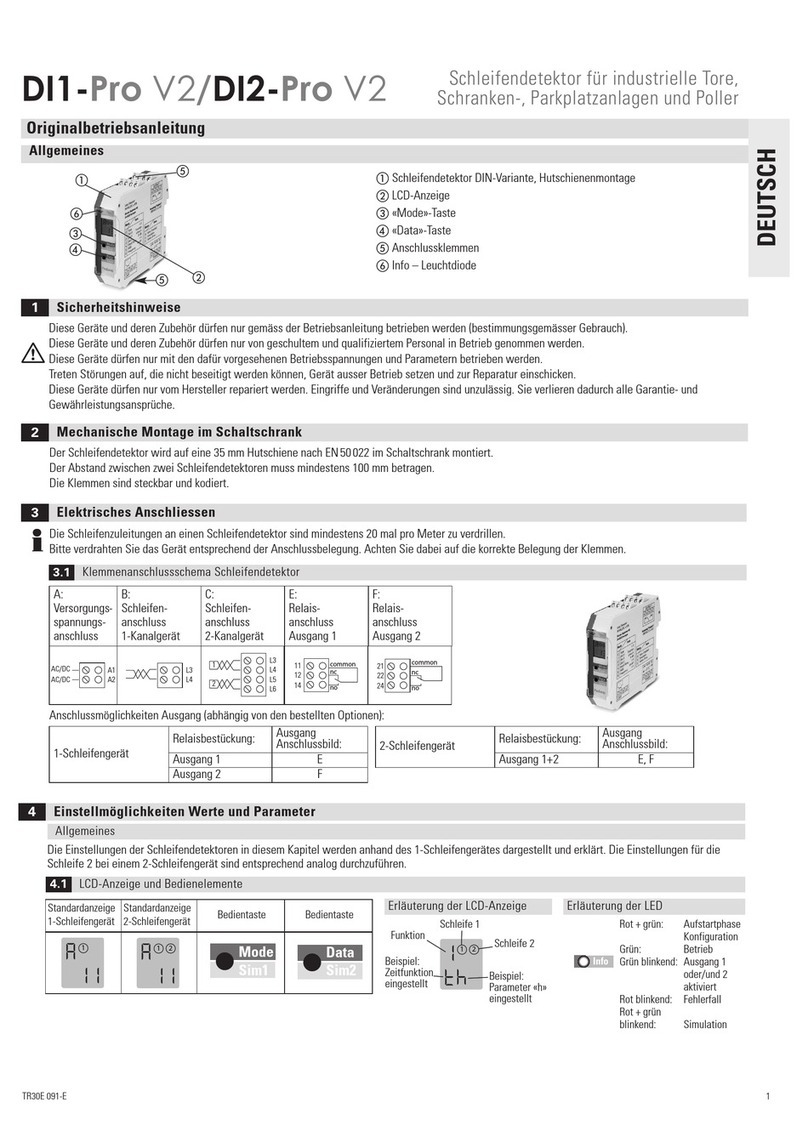
BBC Bircher
BBC Bircher DI1-Pro V2 User manual
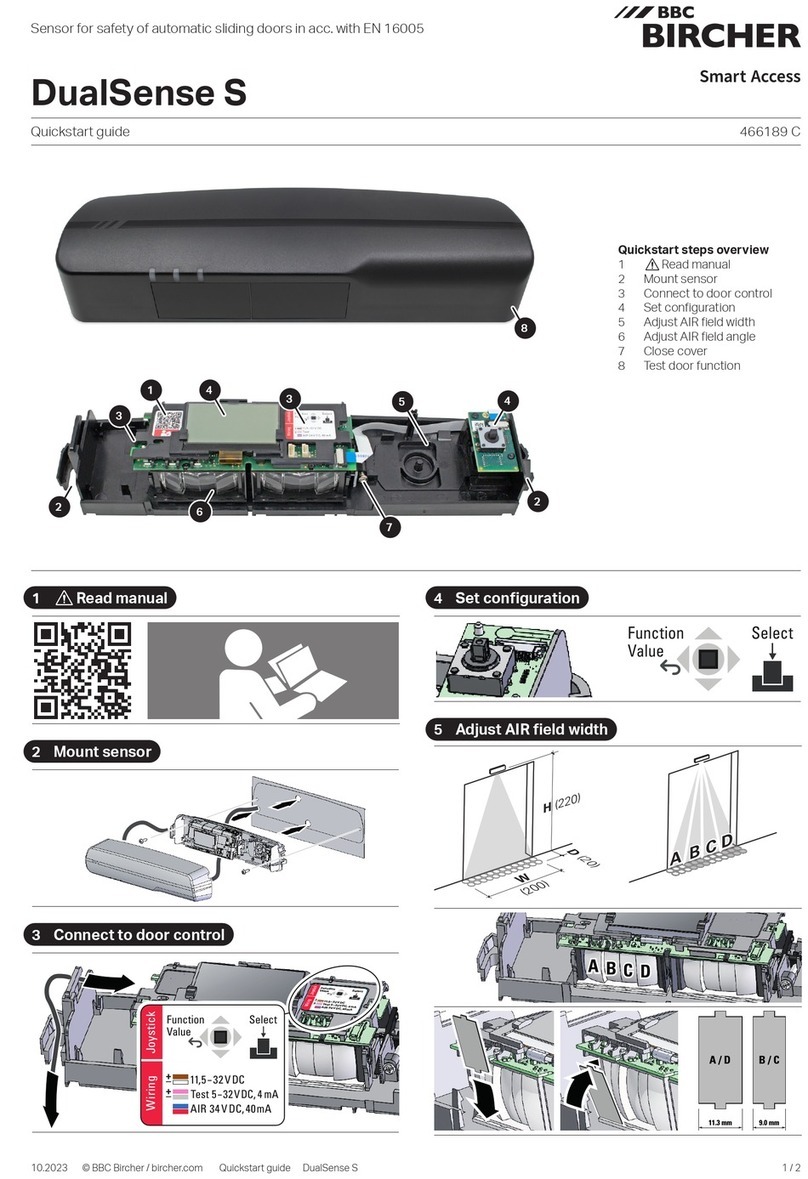
BBC Bircher
BBC Bircher DualSense S User manual
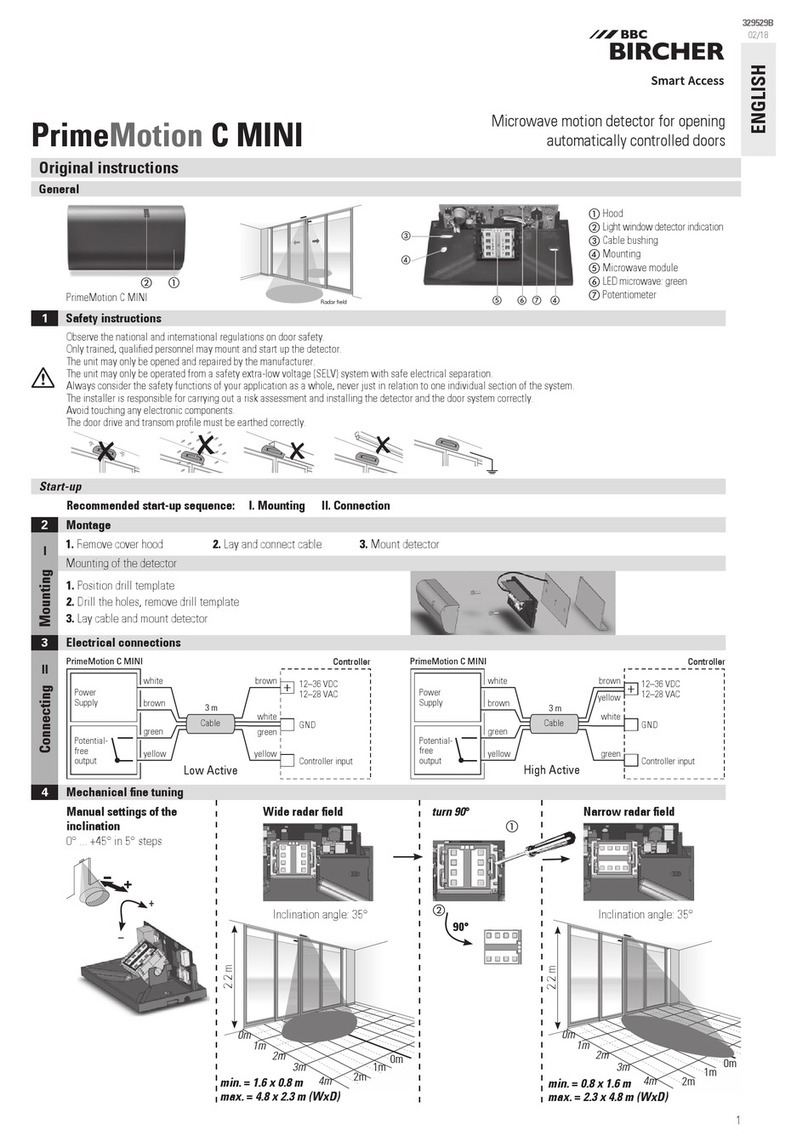
BBC Bircher
BBC Bircher PrimeMotion C MINI User manual
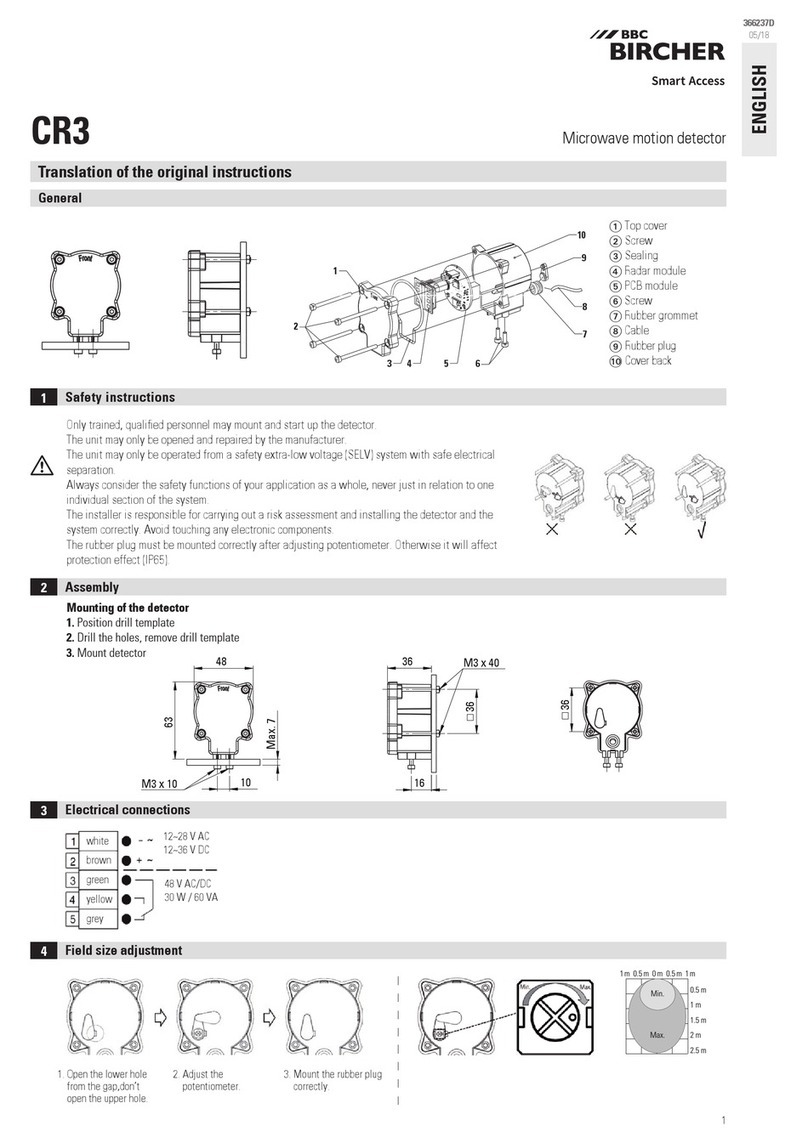
BBC Bircher
BBC Bircher CR3 User manual
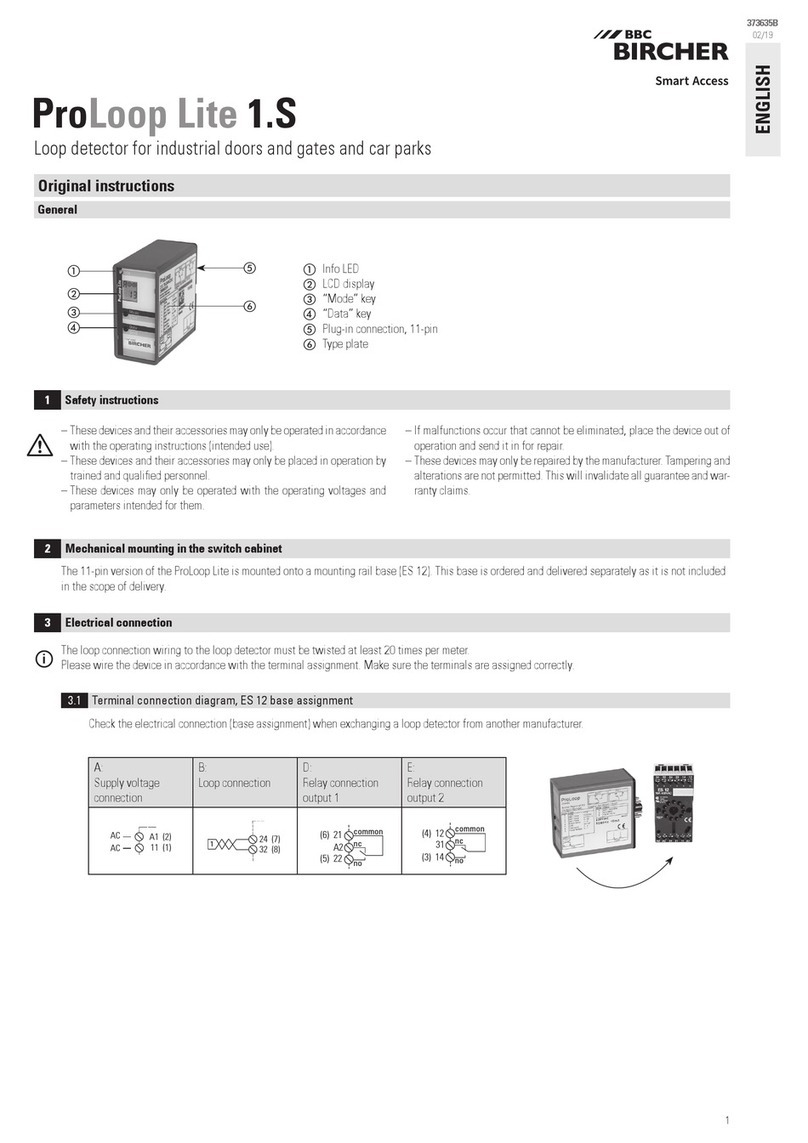
BBC Bircher
BBC Bircher ProLoop Lite 1.S User manual
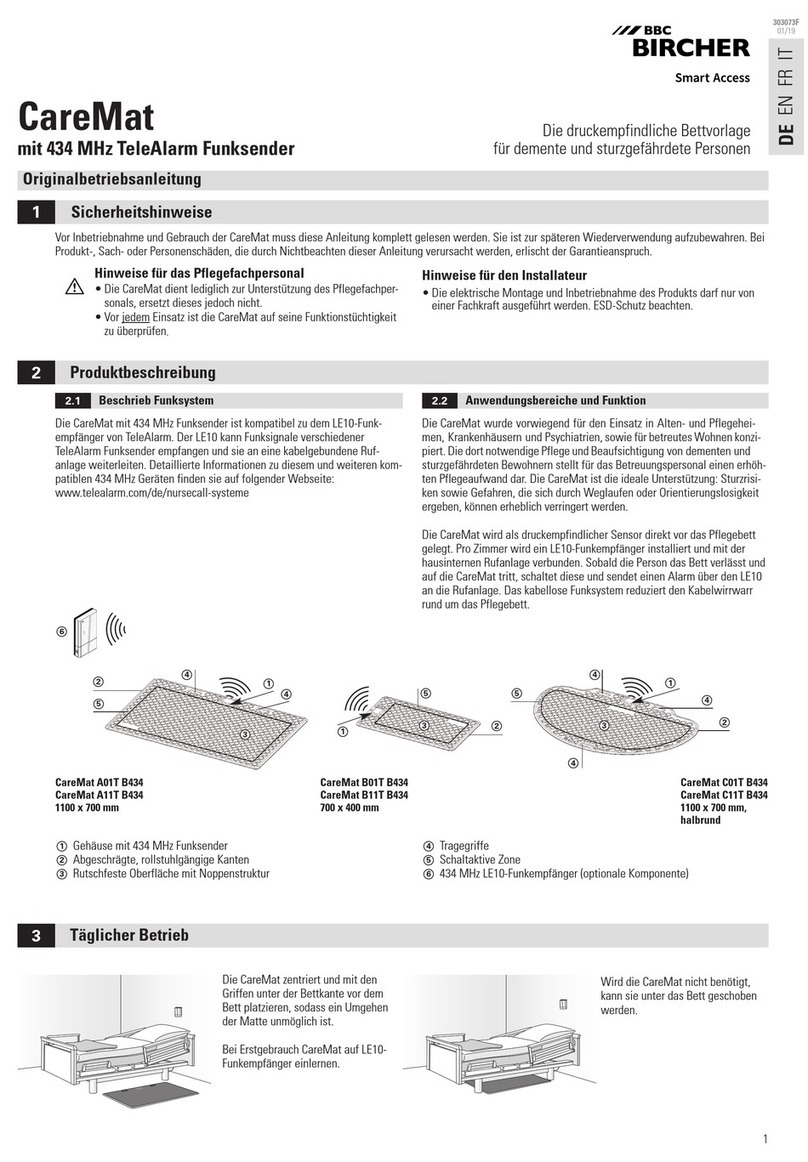
BBC Bircher
BBC Bircher CareMat User manual

BBC Bircher
BBC Bircher ArtMotion 2 User manual

BBC Bircher
BBC Bircher AirMission 2.W2 User manual

BBC Bircher
BBC Bircher TopScan G3 User manual
